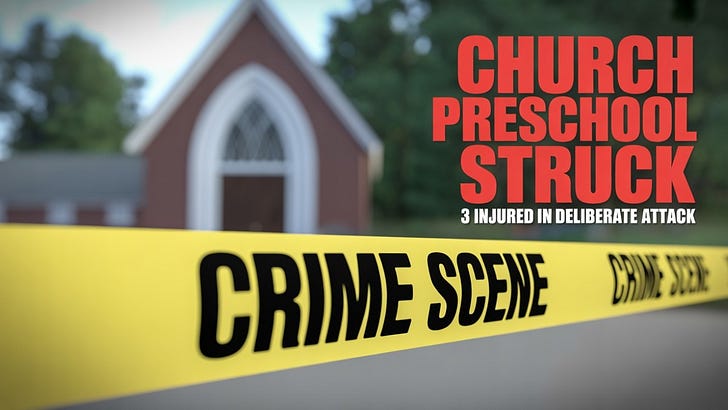A horrifying incident unfolded on May 1, 2025, at Sunrise Presbyterian Church on Sullivan’s Island, South Carolina. In what police are investigating as an intentional act, 36-year-old Justin Collin Adams allegedly used his car as a weapon, driving onto church grounds and striking three people—two children and a teacher.
PREFER TO WATCH THE VIDEO?
Timeline of the Attack
According to law enforcement, the suspect:
Drove onto the preschool’s playground and struck a 12-year-old child.
Then accelerated toward more children seeking shelter, hitting a teacher and sending her airborne.
Finally, drove onto the sidewalk and struck a 10-year-old, pinning the child under the vehicle.
Roughly 40 children witnessed the attack. A federal criminal investigator speaking in court on behalf of the families called the 10-year-old’s survival—trapped with just 4.6 inches of clearance under the car—“a miracle.”
After the crash, Adams fled on foot, possibly armed with a knife. He was eventually apprehended hiding in a boat near the church. He now faces three counts of attempted murder, among other charges.
The Church as a Target
This was not a traffic accident. Police allege the attack was deliberate. There was no reported confrontation or provocation before the incident. The teacher remains hospitalized with serious injuries. Both children have been discharged.
Attacks like this demonstrate that churches are not off-limits for violent actors. This wasn’t during a Sunday service—it was a weekday afternoon when most churches have little or no security presence. The preschool setting, the use of a vehicle, and the suspect’s premeditated escape plan show the kind of tactics we must now consider when planning church security operations.
Ramming Attacks Are Increasing—and Churches Are at Risk
The attack at Sunrise Presbyterian Church was not an isolated event—it was part of a disturbing and growing global trend. Around the world, individuals are turning to vehicles as weapons, deliberately targeting crowds with the intent to kill or injure. Unlike mass shootings, which often require access to firearms and some level of preparation, vehicle ramming attacks are brutally simple: all that’s needed is a vehicle and intent.
At Sullivan’s Island, the suspect didn’t need tactical training or special equipment. He used an everyday object—a car—to cause chaos and harm in a place where children should have been safe. That’s why this method of attack is appealing to emotionally disturbed individuals, ideologically motivated extremists, and those in mental health crisis: it’s accessible, fast, and devastating.
Why Ramming Is Effective—and Hard to Stop
Most churches, like the one attacked in South Carolina, have open access to their playgrounds, parking lots, and worship spaces. This openness is part of their ministry—it makes people feel welcome. But that same openness is a vulnerability. Vehicles can reach children on playgrounds in seconds. An adult walking into service might not think twice about an approaching car until it's too late.
These attacks are increasingly tied to:
Mental illness (as in the Adams case, where he had checked into a psychiatric unit weeks earlier),
Religious or political ideology (as seen in prior attacks around the world),
Personal crisis or rage (often escalating without clear warning).
Not Just Here—A Global Pattern
Recent ramming attacks that mirror what happened at Sunrise Presbyterian Church include:
Vancouver Festival (2025): An SUV drove into a crowd, killing 11 people in what investigators described as an intentional act.
New Orleans (2025): A man drove a pickup truck into a New Year’s Day celebration, killing 15.
Finsbury Park, London (2017): A man deliberately ran over worshippers outside a mosque after prayers, killing one and injuring many more.
These were all soft targets—events or places where security was minimal, where the assumption was “it won’t happen here.” That’s the same assumption many churches still hold today.
What the Church Must Do
The sobering truth is that if your church has a preschool, playground, community event, or open-access weekday ministry, it is at risk. Here are real steps churches can take now:
Install physical barriers: Bollards, concrete planters, or low walls can stop or slow down vehicles before they reach high-risk areas.
Review parking layouts and access points: Don’t make it easy for someone to drive straight onto a sidewalk or into a gathering area.
Train your weekday staff: Many attacks happen during non-worship hours, when security is minimal. Staff and volunteers need to be ready.
Use your team to detect behavioral red flags: In the case of Adams, he had just assaulted a family member and was reportedly acting erratically. These signs are often visible before violence occurs.
What Does the Lord Say About These Acts?
As we face these increasingly violent threats, we must not only prepare tactically—we must respond spiritually.
The Lord speaks clearly about those who seek to harm the innocent. Proverbs 6:16–18 says:
“There are six things the Lord hates, seven that are detestable to him:
haughty eyes, a lying tongue, hands that shed innocent blood,
a heart that devises wicked schemes, feet that are quick to rush into evil…”
What we witnessed in South Carolina was the very embodiment of this kind of evil—innocent blood nearly shed, wickedness enacted with calculated intent. But Scripture also commands us to act in response:
Proverbs 24:11 – “Rescue those being led away to death; hold back those staggering toward slaughter.”
Nehemiah 4:14 – “Don’t be afraid of them. Remember the Lord, who is great and awesome, and fight for your families, your sons and your daughters, your wives and your homes.”
Defending the vulnerable is not just wise—it’s righteous.
Not a Fluke—A Pattern
We are watching a new tactic emerge. It’s not flashy. It doesn’t always make national headlines for long. But it’s simple, lethal, and growing.
This attack was not the first of its kind. It won’t be the last.
If your church leadership isn’t discussing how to mitigate ramming threats, start that conversation today. The enemy is always looking for open doors. We are called to guard them.








Most businesses have something like the barriers you describe. I know and ice cream place with outside seating near where I used to live was told to put up something to keep cars from hitting people seated enjoying their ice cream. A nice landscape planter wall made out of paver stones and concrete with rebar would do wonders to stop someone and least slow it down. Speaking of those planters at the ice cream store they’ve been hit many times just by careless drivers and worked only person hurt was the driver. Just some FYI and thoughts.
KEITH- I thought it might interest you to know that one of your paid subscribers was a ‘high-level graduate’ of Sullivan’s Island Elementary! But as a paid subscriber, I have been trying to reach friends and family for years about how these MANY and VARIOUS threats ARE coming to a town near you. People, please hear me: from the RURAL community in AZ where the GOD-fearing Pastor experienced a Crucifixion-execution, to my ole tiny island town of Sullivan’s, the patterns are the same. By design, the next hit could be metro-Detroit, or Elle, NE. Sullivan’s Island is extremely tiny and peaceful upper white-collar; although when I received my education there with the cute little island girls in the 70’s, it was Jimmy Buffet blue / white collar laid back. If it can happen there, trust me, y’all ‘could be next’! FREE ADVICE? EDUCATE- which should lead you to PREPARATION; that can lead you to TRAINING (with learned discipline); Training should engage your brain as much as your body and your kinetic reflexes, which should cause you to BACK UP. At this point most will have blown past that you need to specifically engage your family and your community. Help them prepare MENTALLY, PHYSICALLY, EMOTIONALLY, and SPIRITUALLY for what is inevitably coming! And listen to Keith 😘